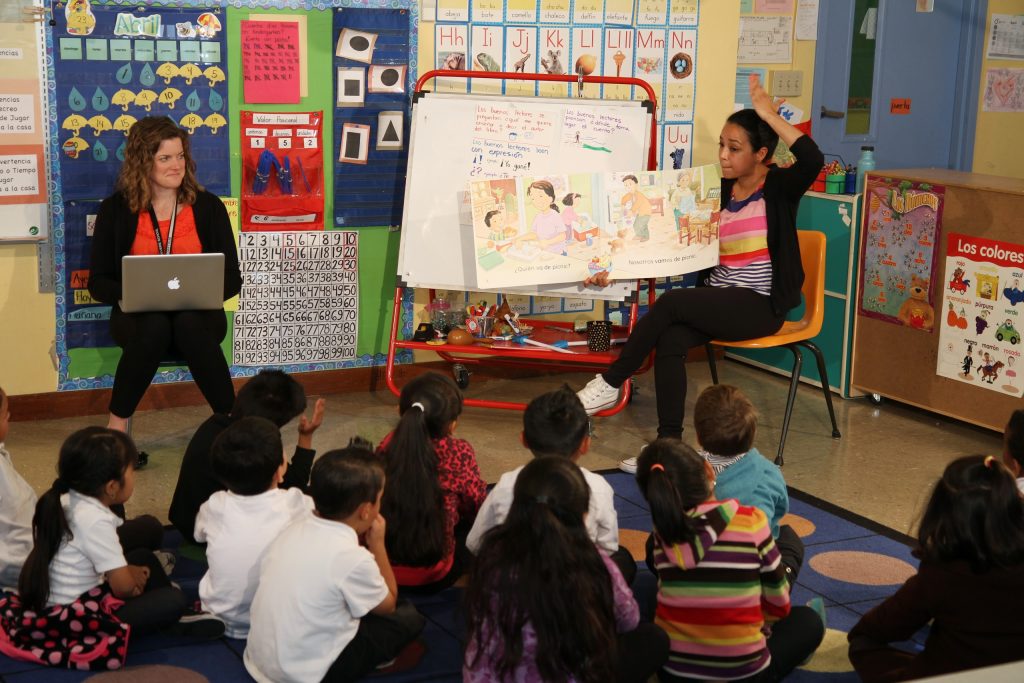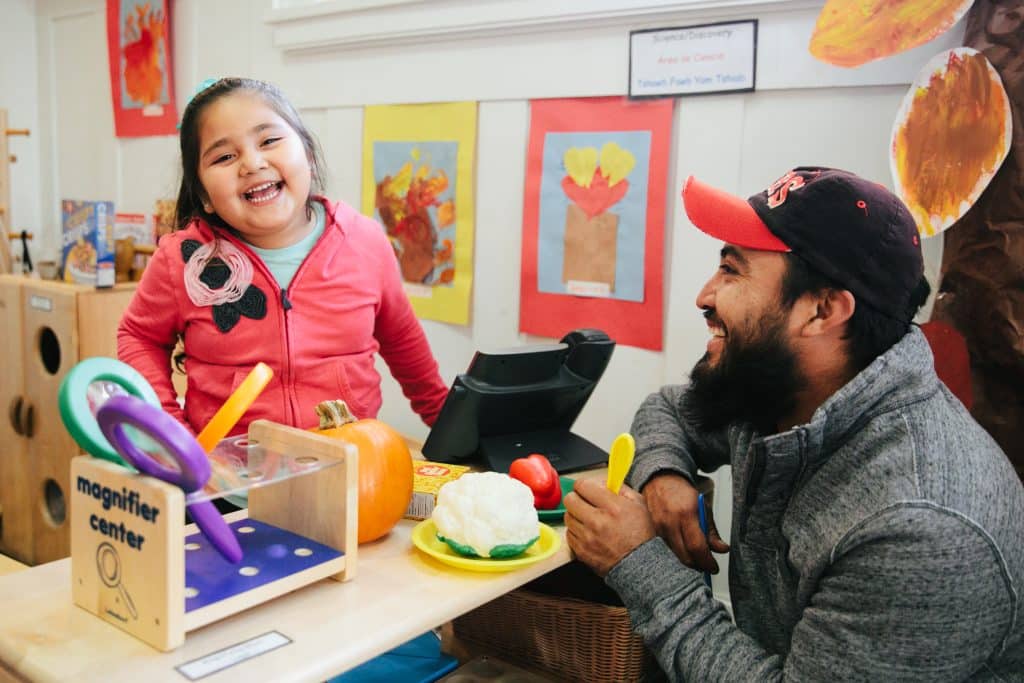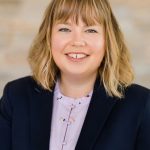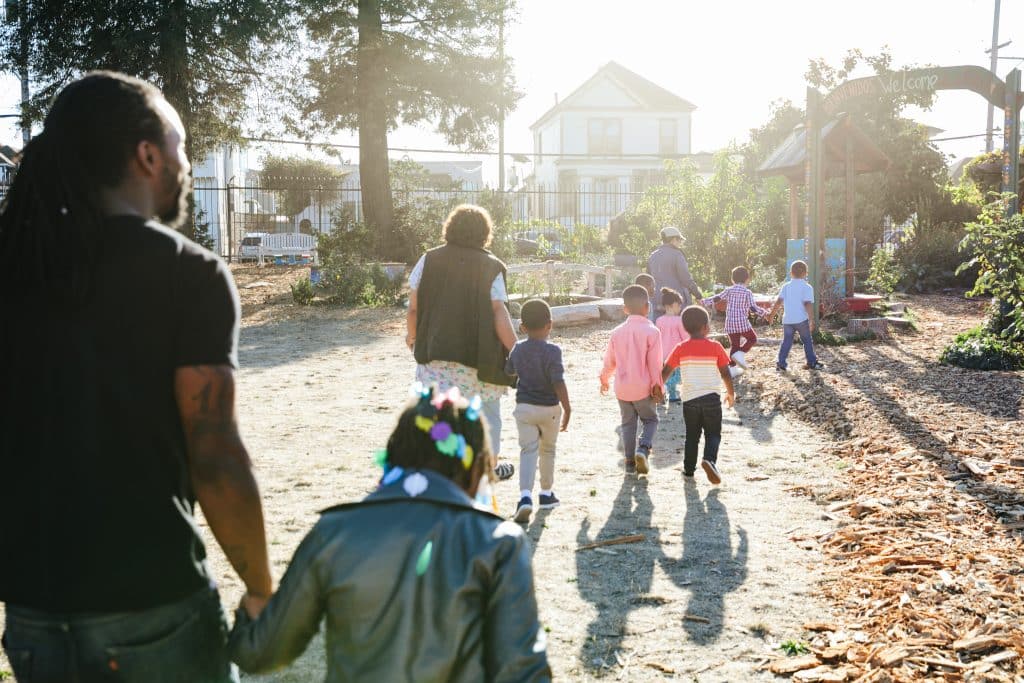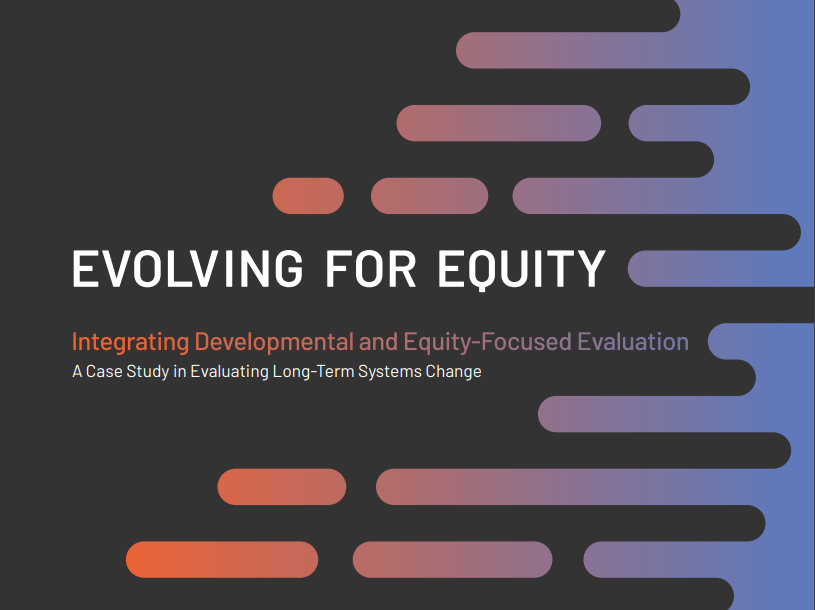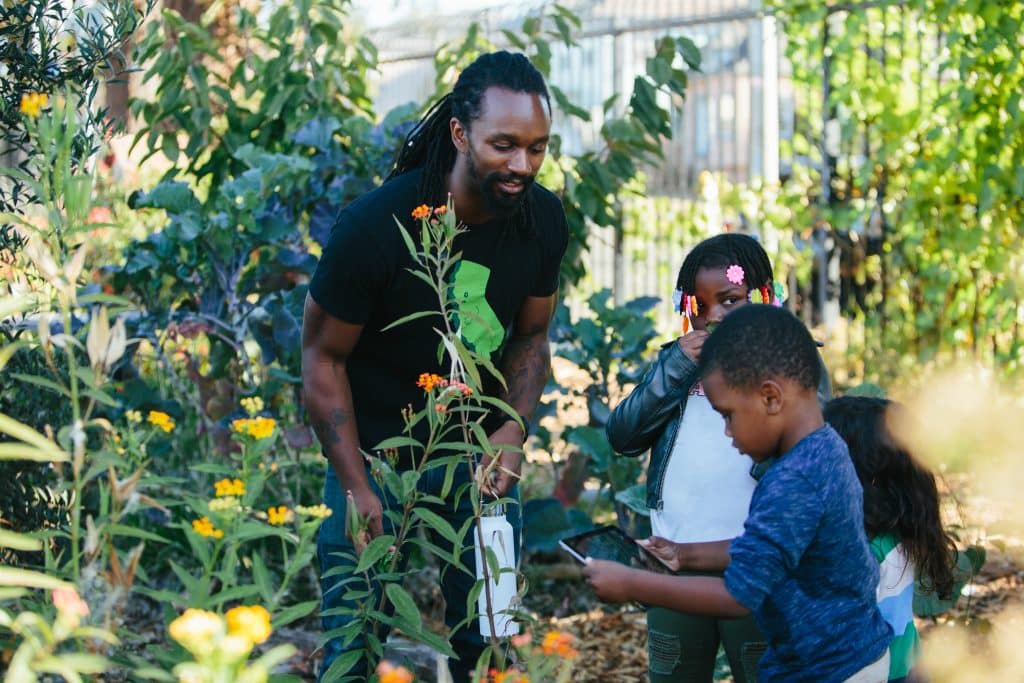Walk through the doors of an Oakland Public Library, and you might not find your stereotypical library setting. The rooms aren’t quiet and hushed. Instead, they are bursting with energy. Visit the system’s Elmhurst or Melrose branch on a Wednesday or Thursday morning and you’ll be greeted by a diverse group of toddlers and their caregivers—not just reading, but singing, playing rhyming games, eating lunch, sharing toys, creating stories and finger puppets, and, most importantly, learning. Children here in Oakland are learning to love the library, and so are the adults in their lives.
Things weren’t always this exciting at the library. Thanks to a new program called “Play Café,” the Oakland Public Libraries (OPL) are experiencing an increase in community engagement like they’ve never seen before.
“It has been a total, shockingly popular, success,” says children’s librarian Mary Dubbs, who works at the Elmhurst Branch and helped spearhead the Play Café programs. “To put it in perspective, in the previous two years at this branch we’ve had 125 people show up for traditional storytime. In two years. In the two months since we’ve started Play Café, we’ve had 320 people come. It’s bananas!”
The libraries still do regular, read-aloud storytimes as well, but they aren’t growing with the same lightning-speed as the new programs. That’s because Play Café is unique in its approach; it’s more interactive, includes a free lunch to children and their accompanying adults, gives away books to regular visitors, and appeals to Oakland’s diverse community with stories and songs in English and Spanish.
Investing in Caregivers
Play Café began as an experiment to reinvent what the library can be for the communities that surround them–neighborhoods in east and central Oakland, California, where people come from a wide array of cultures, languages, and socioeconomic statuses.
Inspiration for the new structure came from all over. Dubbs and Kate Hug, a fellow children’s librarian from the Melrose branch, wanted to test different ideas to explore how they could better engage young children and their caregivers. Ideas included offering unstructured storytime—longer programs where children and caregivers could arrive and leave when they needed to, being more flexible and therefore more accessible to adults with changing schedules. They incorporated ideas from their colleagues on play and sensory equipment, using toys to create even better environments for play.
A study on informal care by the Packard Foundation also informed their work. Informal care refers to childcare provided by family, friends or neighbors, who are sometimes called “informal caregivers”—as opposed to “formal caregivers”, such as daycare providers, teachers and other licensed professionals. The study provided information on what resources parents and other informal caregivers want, such as hearing from experts and learning about improving the health of their children through healthy food and exercise.. According to Hug, the report “helped us crystallize these different ideas and figure out what to target. We wanted to be responsive to what the community wanted.”
The librarians realized that one of the best ways to impact the youngest members of the community was to serve as a resource for the adults in their lives. Roughly 80 percent of infants (and 40 percent of children under the age of six) are cared for by informal caregivers, and play a critical role in providing healthy and high-quality environments that lay the foundation for children’s growth. Caregivers make a lot of decisions for children, from what they eat to what songs they sing and games they learn, which has a significant impact on their learning and development. Yet informal caregivers often face isolation; unlike formal caregivers like teachers and licensed daycare providers, many parents, grandparents, and neighbors don’t normally have access to a network of support or have training on the best practices for instilling a love of learning in children.
Responding to the needs of parents and other caregivers stood out as vital to the library’s work. Accordingly, they began to design a program to reach all the adults in the Melrose and Elmhurst neighborhoods who are caring for children.
To support informal caregivers, who range from parents to neighbors and extended family, Dubbs said, the OPL set out to “make more of a deconstructed storytime, involving more aspects of community building—[including] play groups, education for adults, and more incentives so people could take learning home with them after Play Café.”
Play Café began as an experiment to reinvent what the library can be for the communities that surround them.
Packard’s Investments
To make this program a reality, the librarians reached out to the Packard Foundation for support. The Foundation was looking to take its recent study on the needs and wants of parents and other caregivers, and test the hypotheses from the research in real life settings. Specifically, they were looking to help create networks that “support parents, family, friends and neighbors that are caring for infants or toddlers—and provide them with skills and supports they need to create healthy learning environment, help children grow and get them ready for success in school and life,” according to India Alarcon, analyst for Packard’s Children, Families and Communities program.
The program at OPL was one of four selected by Packard to receive funding to test ideas that support informal caregivers. The other programs include:
- Lotus Bloom, a family resources center in Oakland that is building up caregiver leaders in the community to serve as ambassadors in natural gathering places for caregivers, such as laundromats and barbershops.
- A program with the Fresno Housing Authority that is establishing a family resource center in the heart of a high-need neighborhood to build a place for caregivers to go for resources where they live.
- A texting program in San Jose that is sharing research-based facts, tips and activities for caregivers to do with infants and toddlers—all aimed at arming adults with critical information on early childhood development.
Like the library program, each of these programs reflect what Nina Lindsay, OPL’s Supervising Librarian of Children’s Services, calls, “an experiment model.”
“We do a lot of designing and testing and development of different ideas on stretched resources—trying to meet a lot of different needs in different ways,” says Lindsay. “Supportive partners allow us to try something different that really works.”
Word about the program spread from friend to neighbor, unearthing a network of caregivers within the community.
An Attitude of Experimentation
At OPL, that open attitude toward experimentation paid off right from the beginning. To let caregivers in the neighborhood know about the new program at the Melrose and Elmhurst branches, Dubbs explains, “We did outreach in ways the library hasn’t done much of before. We showed up at schools as they were letting out and parents were dropping off their children. We approached anyone with a stroller and gave them a free book and nice postcard about the program.”
After just one month of outreach, there was no need to continue looking for more toddlers to join. Word about the program was spreading from friend to neighbor, unearthing a network of caregivers within the community. Librarians had to take over multiple floors and expand their Play Café space to the patio to accommodate all the kids and adults who wanted to join.
The libraries have experimented with incentives too, raffling off a toy each session, and giving the kids a set of books to take home after every four visits. The kids are thrilled to add books to their libraries and learn new songs, but the caregivers are learning too.
“We’re able to model specific types of learning that can be taken home,” says Dubbs. “[I hear caregivers] say, ‘The kids love hearing the same thing over and over.’ And I’ll respond, ‘Absolutely. Kids are making connections over and over, which is reinforcing those language skills. It might be tedious to us, but it’s so important for them.’ And it’s important, as a caregiver, that they recognize and support that growth.”
The library is making sure that they are there to support the caregivers that in turn, support those children. “We have a mom coming recently,” explains Dubbs, “whose son—maybe he has some learning setbacks? He doesn’t verbalize in the way a kid his age typically does, and he has pretty aggressive tantrums. I can see the mom is trying so hard, [but] it’s exhausting for her.” Hug reached out and talked to the mom about her support network, the doctor her son was seeing, and the benefits of interacting with other children in a structured way. Surely enough, “he’s getting better. He’s better at sharing [with other kids] in just over a month.” And, just as importantly, “the program is making his mom feel more confident, too. She brings him to the library almost every day, not just to the program.”
The librarians are seeing change beyond storytime. “We’re a building a community.”
Transforming Families, Caregivers, and Communities
The librarians are seeing change beyond storytime. “We’re a building a community,” Hug explains. Dubbs agrees, and is already seeing how the families at the Elmhurst branch are benefiting.
“These kids, they have a sense of community when they grow up in the library. Parents are able to do activities with their kids and they do them every day, they have a librarian to do it with them, they trade songs and stories with other people—they feel supported in playing, reading and singing with their children. They don’t have to do it solo.”
The program has also brought together neighbors in unexpected ways. Children and the adults in their lives are building friendships, despite language, racial or socioeconomic barriers. A camaraderie is developing between adults and families, tells Hug. “They’re interacting, their kids are becoming friends and having fun—sometimes even families leave the library to go to the park together after Play Café is done!”
And the effects are rippling out to not just affect toddlers. “Almost all those who come to [the program] were not library users before,” Hug explains. “Now they bring their older school-age kids and get library cards. They are using ESL resources themselves, they are checking out materials for themselves, connecting with other parents and caregivers they wouldn’t interact with otherwise. These families have everything to gain from all the things the library has to offer.”
Learning What Works
As Play Café continues to grow, the librarians are continuing to learn what works and adjust the program to best meet the needs of families in the community. They track the number of children and adults, both newcomers and returning visitors to the program, each week. They also detail their successes and teachable moments, from noting the capacity limitations of the room to identifying how helpful it is to explain the bilingual format of the songs and stories to newcomers.
And they are working with Harder+Company, a research group, to help them conduct interviews with the program attendees. They are hoping to learn what is working, what isn’t, and to discover the nuanced needs of the families the libraries serve. Over the course of the year-long grant, they’ll be conducting three rounds of 30 interviews to figure out what makes this program such a success, in hopes of replicating it in other libraries.
What’s Next
The group at OPL are excited about the possibility of growing past their own branches.
“I’d like to see us try it at other locations [in Oakland],” says Dubbs. “The playgroup model seems to work with people relaxing, talking with each other, playing with their kids. I want to figure out what is the magic mix [so we can] replicate it.”
Hug also wants to expand the project to Saturdays and to make it available to older kids and their families.
“We are still studying and working at it,” says Lindsay, “to see what’s scalable and replicable to see where we can continue. That’s the most exciting thing—we had some ideas, and they’re working!”
And they’ll have a chance to share that learning soon. Packard is bringing leaders from all four informal caregiver projects together so they can learn from one another, understand how caregivers benefit from support networks, and help Packard explore the benefits of this kind of flexible and experimental grant-making. They may also see if this kind of program could be scalable to other libraries across California.
But in the meantime, Hug, Dubbs and Lindsay have their hands full. “Nine people who came today heard about it from friends,” recalled Dubbs, “One person showed up with a baby and three year old and said, ‘I just got a text from a friend that something really fun is going on—so I’m here!’”
